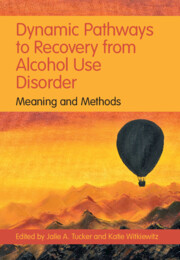Book contents
- Dynamic Pathways to Recovery from Alcohol Use Disorder
- Dynamic Pathways to Recovery from Alcohol Use Disorder
- Copyright page
- Dedication
- Contents
- Figures
- Tables
- Contributors
- Foreword
- Preface
- Acknowledgments
- Introduction
- Part I Micro Level
- Part II Meso Level
- 9 Natural Recovery from Alcohol Use Disorder
- 10 Individual Behavioral Interventions to Incentivize Sobriety and Enrich the Natural Environment with Appealing Alternatives to Drinking
- 11 Family and Social Processes in Recovery from Alcohol Use Disorder
- 12 Community-Based Harm Reduction Approaches for Alcohol Use Disorder
- 13 Use of Mobile Technology to Understand and Improve Recovery from Alcohol Use Disorder
- 14 Studying Recovery in the Social Context
- 15 Measuring Substance Use Contexts and Substance-Free Reinforcement
- Part III Macro Level
- Conclusions and Future Directions
- Index
- References
14 - Studying Recovery in the Social Context
A Primer on Methods for Measuring and Modeling Social Network Data in Applied Recovery Research
from Part II - Meso Level
Published online by Cambridge University Press: 23 December 2021
- Dynamic Pathways to Recovery from Alcohol Use Disorder
- Dynamic Pathways to Recovery from Alcohol Use Disorder
- Copyright page
- Dedication
- Contents
- Figures
- Tables
- Contributors
- Foreword
- Preface
- Acknowledgments
- Introduction
- Part I Micro Level
- Part II Meso Level
- 9 Natural Recovery from Alcohol Use Disorder
- 10 Individual Behavioral Interventions to Incentivize Sobriety and Enrich the Natural Environment with Appealing Alternatives to Drinking
- 11 Family and Social Processes in Recovery from Alcohol Use Disorder
- 12 Community-Based Harm Reduction Approaches for Alcohol Use Disorder
- 13 Use of Mobile Technology to Understand and Improve Recovery from Alcohol Use Disorder
- 14 Studying Recovery in the Social Context
- 15 Measuring Substance Use Contexts and Substance-Free Reinforcement
- Part III Macro Level
- Conclusions and Future Directions
- Index
- References
Summary
Social networks often play critical and complex roles in the recovery process. Recent advancements in methods for measuring and modeling social networks create opportunities to advance the science of recovery by testing theories and treatment models with a more explicit focus on the dynamic roles of social environments. This chapter provides a primer on several methods for measuring and modeling social network data, including those that use egocentric approaches (i.e., where social networks are modeled as characteristics of individuals) and sociocentric approaches (i.e., where social networks are modeled as complete entities of interconnected individuals). Aspects of measurement and analysis that commonly differ for social network data are highlighted. Examples of research on substance use disorders that apply these methods are also described to illustrate the types of insights that may be obtained using these approaches.
Keywords
- Type
- Chapter
- Information
- Dynamic Pathways to Recovery from Alcohol Use DisorderMeaning and Methods, pp. 260 - 279Publisher: Cambridge University PressPrint publication year: 2022



